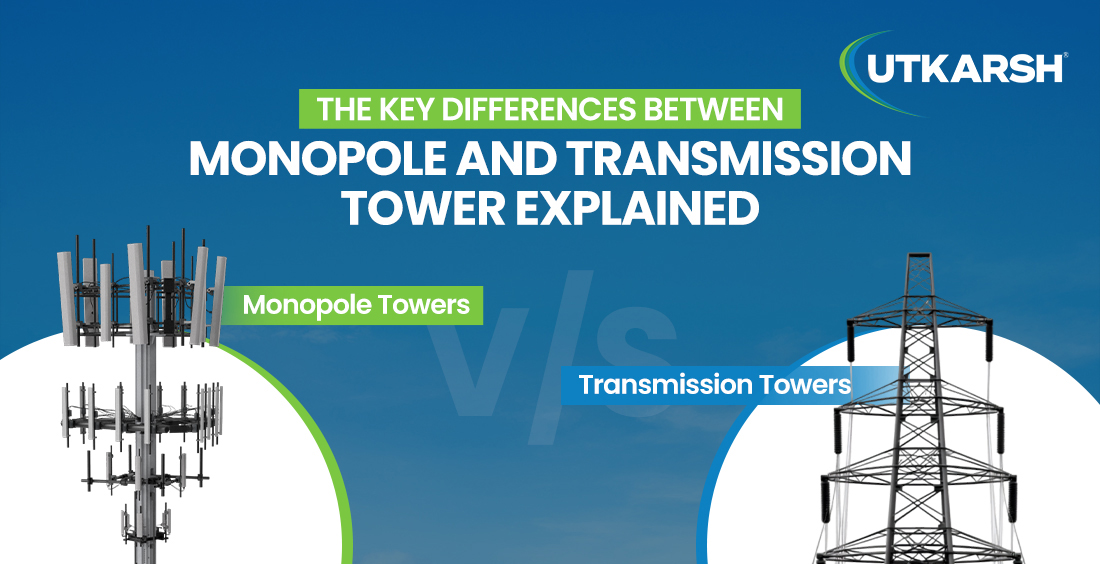The Key Differences Between Monopole and Transmission Tower Explained

In today’s fast‑growing urban and industrial landscapes, the need for efficient and reliable telecommunication and power distribution infrastructure is more critical than ever. Two prominent structures that support these networks are the monopole transmission tower and traditional transmission towers.
While both serve the primary function of carrying power lines and telecommunication signals, their design, installation, and suitability for different environments vary significantly. Understanding these differences is crucial for engineers, contractors, and urban planners alike.
What is a Monopole Tower?
A monopole is a single tubular pole that supports antennas or power lines. Unlike the lattice framework of traditional transmission towers, monopole transmission towers have a sleek, vertical design, making them an ideal solution for urban and suburban areas with space constraints. Their single-pole structure allows for easier installation and lower maintenance costs compared to larger lattice towers.
Key Features of Monopole Towers:
- Sleek, tubular design that occupies minimal space
- Ideal for urban and suburban deployment
- Easier and faster to install than lattice towers
- Requires less maintenance and material
What is a Transmission Tower?
A transmission tower is a tall, lattice-structured tower used to support overhead power lines or communication antennas. Traditional transmission towers are often made of steel and come in various shapes, including lattice, tubular, and self-supporting frameworks. They are designed to withstand harsh environmental conditions, including high winds, heavy loads, and seismic activity. Transmission towers are ideal for areas that require high-capacity power transmission or extensive telecommunication networks.
Key Features of Transmission Towers:
- Typically made from steel lattice structures
- Can support multiple high-voltage lines
- Suitable for long-distance power and signal transmission
- Requires significant land space for installation
Monopole vs Transmission Tower: Head-to-Head Comparison
| Feature | Monopole Tower | Transmission Tower |
|---|---|---|
| Design | Single tubular pole | Lattice or framework structure |
| Space Requirement | Minimal, suitable for constrained areas | Large footprint, needs more land |
| Installation Time | Quick and straightforward | Longer and complex |
| Maintenance | Low maintenance | Requires frequent inspection |
| Load Capacity | Suitable for light to medium loads | Can carry heavy loads and multiple lines |
| Cost | Relatively lower | Higher due to material and complexity |
Types of Towers
Choosing the right tower type is crucial for efficient power and telecommunication infrastructure. Utkarsh India provides high-quality solutions for all major tower types, ensuring reliability and durability:
- Transmission Tower – Large lattice structures designed for high-voltage power transmission across long distances.
- Telecom Tower – Supports antennas and communication equipment for mobile networks, internet, and broadcasting services.
- Substation Structure – Specialized towers and frameworks used within substations to support transformers, circuit breakers, and electrical equipment.
- Monopole Transmission – Single-pole towers combining a compact design with reliable support for medium-voltage power lines or telecommunication antennas.
- Transmission Power Distribution Pole – Poles designed for distributing electricity to residential, commercial, or industrial areas, offering cost-effective and safe solutions.
Why Choose Utkarsh India for Tower Solutions?
Whether it’s transmission towers for heavy-duty power networks or transmission monopoles for space-saving urban installations, Utkarsh India provides advanced engineering, durable materials, and expert installation services for all types of towers.
By offering a complete range of tower solutions, Utkarsh India ensures that contractors, utility providers, and telecom operators can rely on safe, high-performance infrastructure for every project.
Conclusion
Choosing the right tower depends on your project requirements. For urban-friendly, space-efficient solutions, monopole transmission tower are ideal, while traditional transmission towers excel in high-capacity, long-distance power and telecom networks. With Utkarsh India Limited, you gain a trusted partner for designing, supplying, and installing robust tower solutions that meet modern infrastructure demands.
Backed by over 40 years of experience, Utkarsh India has successfully completed numerous projects across the country, earning the trust of both industry leaders and government agencies. The company is an approved vendor for BSNL, supplying 20m, 30m, and 40m narrow-based ground towers, and collaborates with top telecom operators including Reliance, Indus, and Airtel.
Utkarsh India’s commitment to quality is reinforced through sourcing raw materials only from reputed suppliers such as SAIL, TATA, RINL, JINDAL, Hindustan Zinc, PGCIL-approved sources, CORE-approved sources, and BIS-approved sources, ensuring unmatched material integrity and long-lasting performance.
With Utkarsh India, every tower project is delivered with precision, reliability, and industry-leading expertise, making them the preferred choice for India’s growing digital and power infrastructure.
FAQs
1. What is the difference between a monopole tower and a transmission tower?
A monopole tower is a single-pole structure ideal for urban areas and medium-voltage lines, whereas a transmission tower typically has a lattice framework designed to carry high-voltage lines over long distances. Both play essential roles in India’s power and telecom infrastructure.
2. Where are monopole transmission towers commonly used?
Monopole transmission towers are widely used in urban and suburban areas where space is limited. They support antennas, medium-voltage power lines, and telecom networks while providing a compact, efficient alternative to larger lattice towers.
3. How do transmission towers support power and telecom networks?
Transmission towers are engineered to carry heavy loads of high-voltage power lines or multiple telecom antennas over long distances. Their lattice or self-supporting structures ensure stability, reliability, and minimal maintenance requirements, even in extreme weather conditions.
4. Why choose Utkarsh India for monopole and transmission tower solutions?
With over 40 years of experience, Utkarsh India is a trusted provider of monopole and transmission towers, approved by BSNL and partnered with top telecom operators like Reliance, Airtel, and Indus. Using high-quality materials from SAIL, TATA, JINDAL, and other reputed suppliers, Utkarsh ensures long-lasting, safe, and reliable tower solutions for every project.